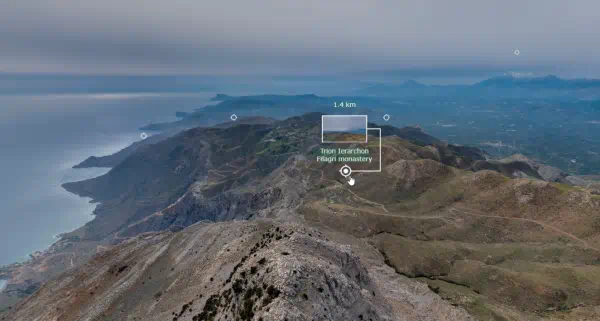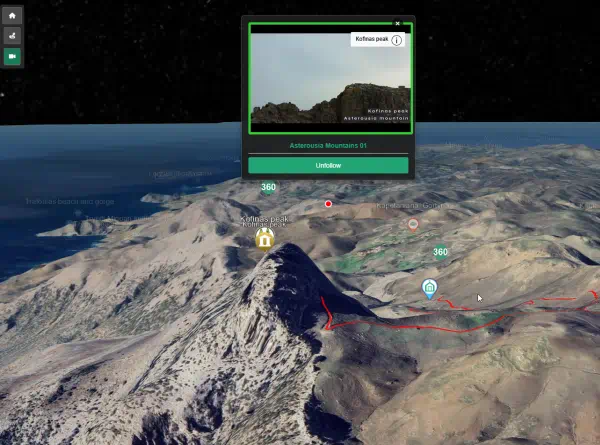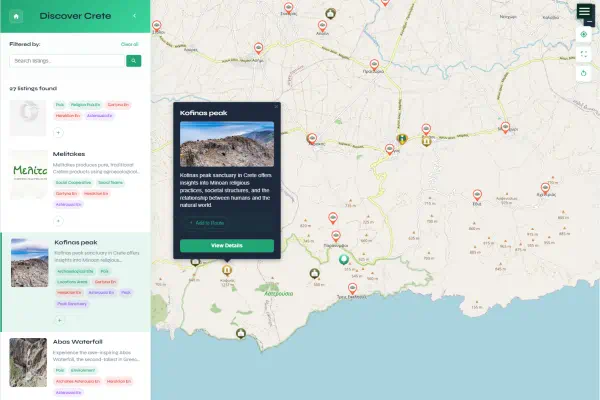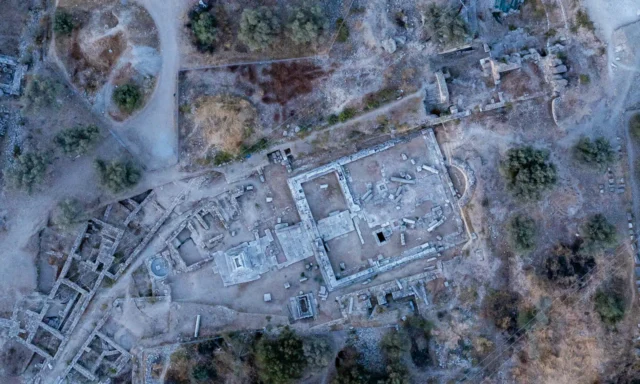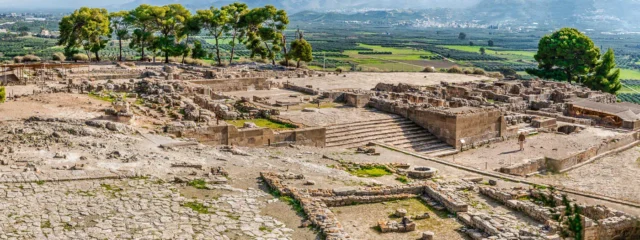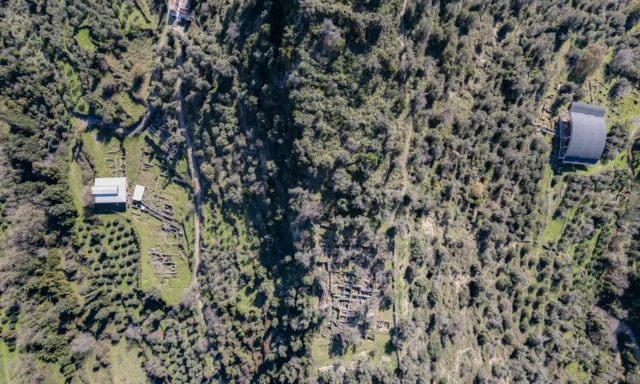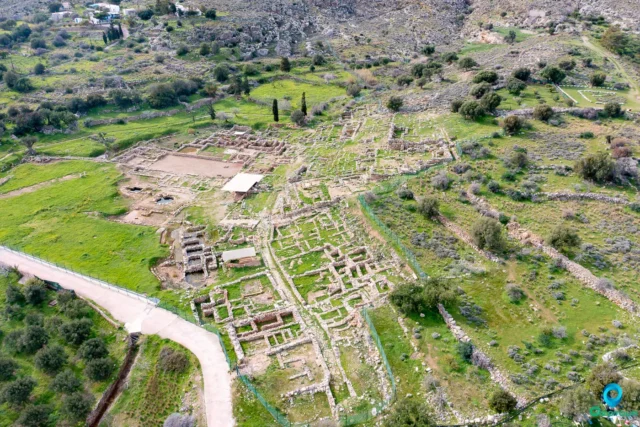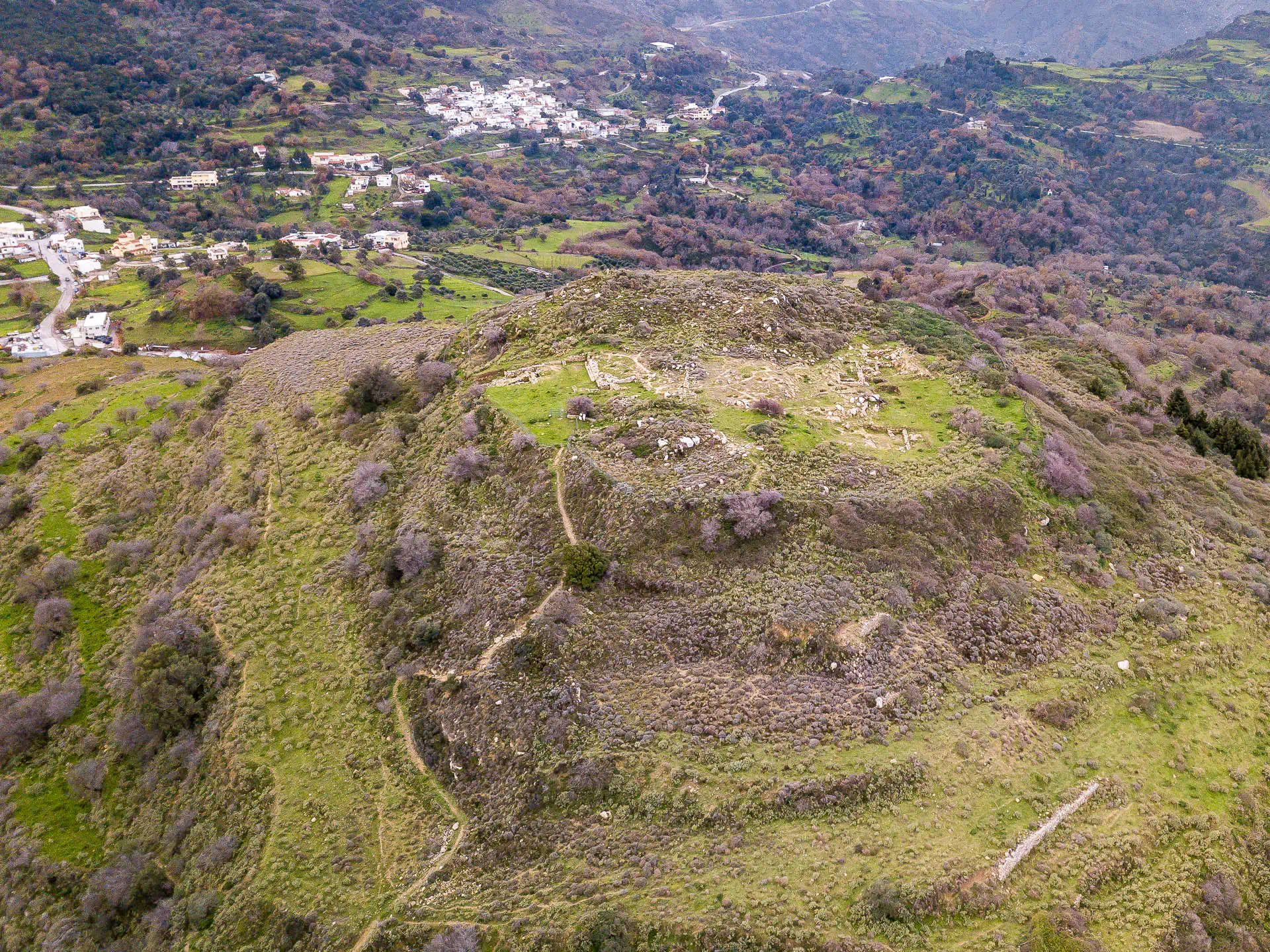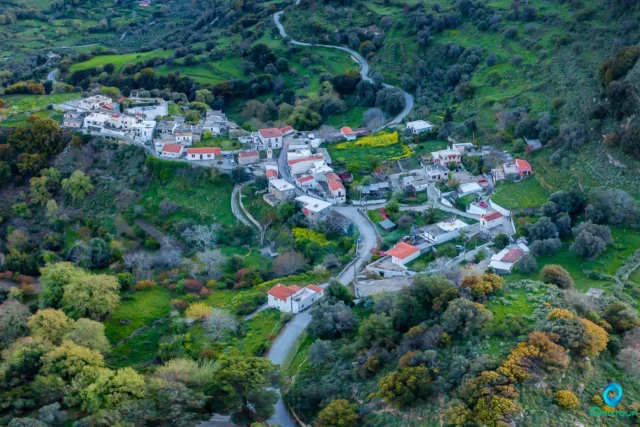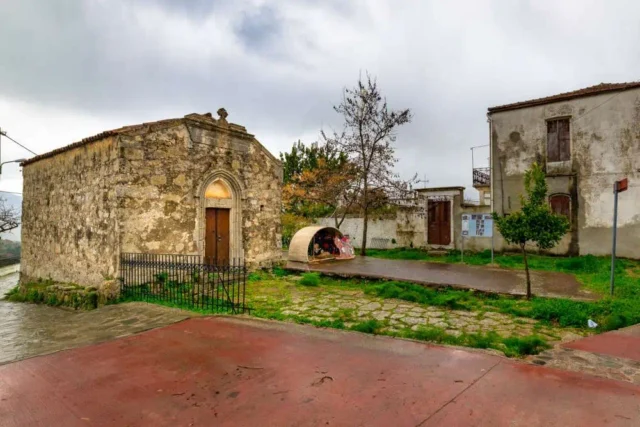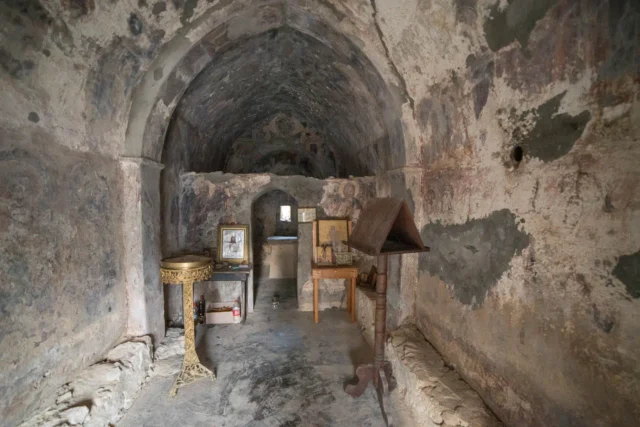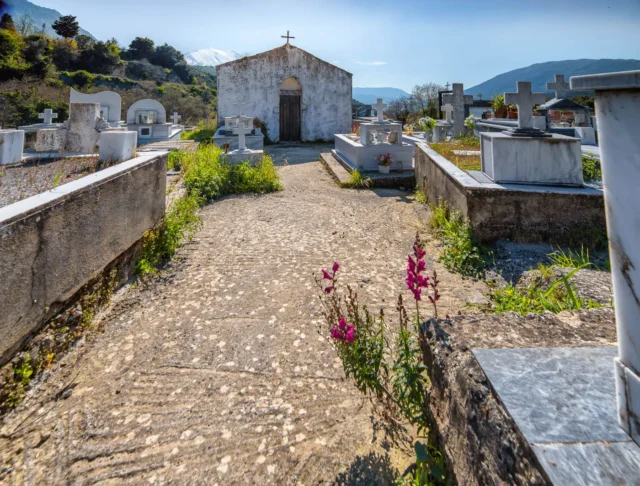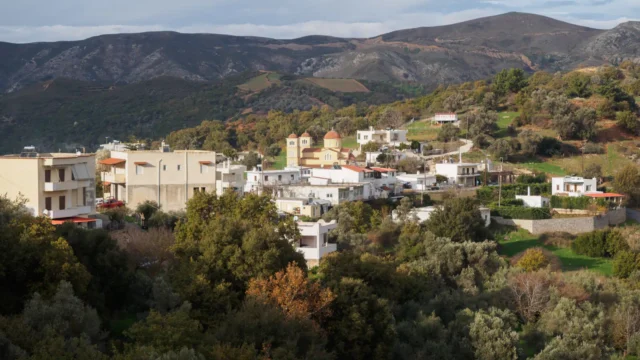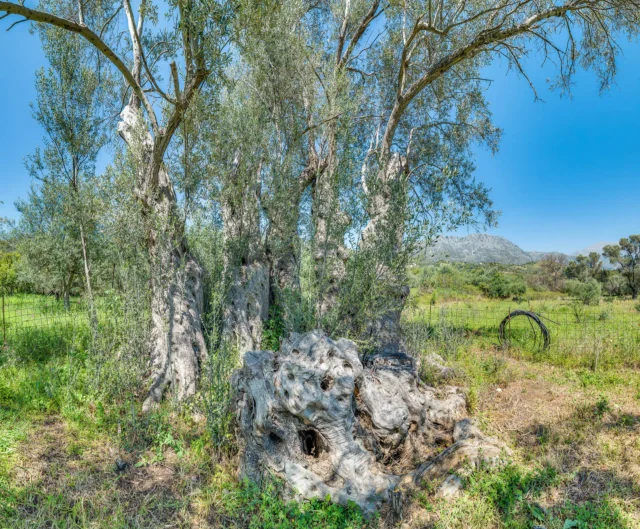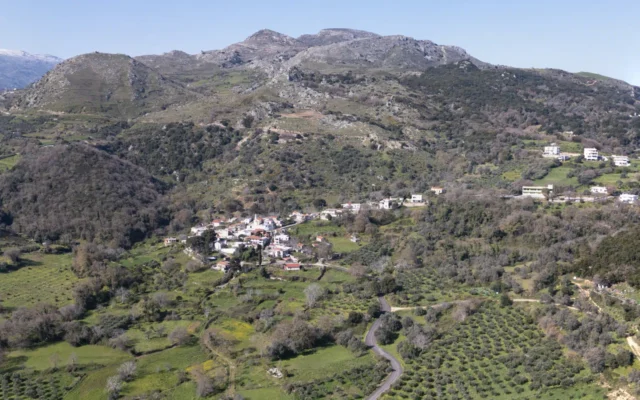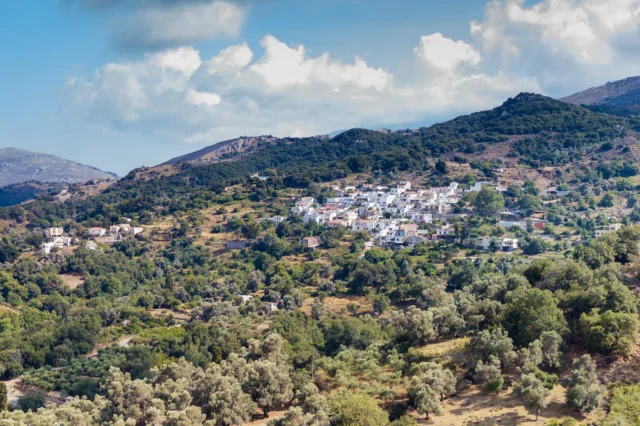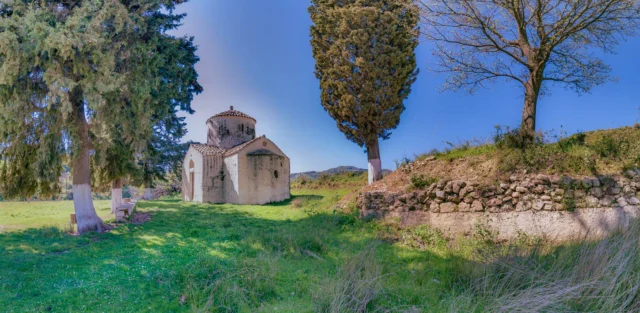The archaeological site of Thronos Kephala is situated on the edge of the western slopes of the Psiloritis massif at the northern end of the Amari valley in central-western Crete. It is located on the territory of the Greek and Roman city of Sybrita. The modern village of Thronos is located near the acropolis on Kephala hill.
Thronos Kephala is generally identified as the predecessor of the ancient polis of Sybrita, and potentially with the Minoan su-ki-ri-ta. Excavations at Thronos Kephala have revealed a significant settlement with continuous occupation from Late Minoan times onwards, displaying important evidence for the Early Iron Age in Crete. Notably, a clay figured krater discovered in 2002 features the oldest scene of armed dance in Greek vase-painting. The site also contains evidence of ritual behavior in the form of numerous pits used for the structured deposition of food remains and pottery from the 12th to the 9th century BCE.
The Origins and Flourishing of Ancient Sybrita
Nestled on the hill of Kephala, near the modern village of Thronos in central-western Crete, lay the ancient settlement of Sybrita, a site with a history stretching from the close of the Late Minoan Period. Archaeological investigations have revealed that the earliest structures on Kephala were established at the very end of the Bronze Age, marking the genesis of a community that would endure for many centuries. Its strategic position, commanding routes between the northern and southern coasts of the island, contributed significantly to its long-term importance.
The Dawn of the Early Iron Age
The Early Iron Age, encompassing the Subminoan, Protogeometric, and Geometric periods, witnessed significant developments at Thronos Kephala. A defining characteristic of the settlement during this era, particularly from the 12th to the 9th centuries BCE, was the presence of over forty pits discovered in the central area of the hilltop. These pits were not simply for storage; rather, their careful construction, spatial organization, and the nature of their infill strongly suggest a ritual function. The deposits within these pits, consisting primarily of pottery, animal bones, and organic remains, represent the remnants of collective meals held on Kephala over centuries, imbued with ritual significance. These communal feasts can be seen as precursors to the syssitia, the common meals that later became a crucial institution in the Cretan poleis during the Archaic Period. This practice underscores the early development of communal identity and shared ritual within the settlement.
The end of the eleventh and the tenth centuries BCE appear to have been a period of notable transformation. Archaeological evidence hints at a rise in social tensions linked to the control and exploitation of the territory and its resources, fostering fierce competition among co-resident social groups. This environment of tension likely reinforced the internal cohesion of individual groups, potentially leading to the formation of an aristocratic-like ideology where manhood, warrior status, and collective identity were redefined. A remarkable discovery that illuminates this crucial stage is a clay figured krater found at Thronos Kephala. This vessel bears the oldest known representation of an armed dance in Greek vase-painting, providing a unique pictorial record of the political and social transformations taking place on Crete at the dawn of the first millennium BCE. This krater underscores the emergence and importance of warrior culture and collective identity within the community.
Ceramic production at Thronos Kephala during the 12th and 11th centuries BCE (Late Minoan IIIC and Subminoan) demonstrates the development of local pottery workshops exploiting nearby raw materials. Simultaneously, there was circulation of ceramics from the intra-regional area and connections with other parts of the island, including the Messara, the Rethymnon coast, and north-central Crete. By the 10th century BCE, the site’s relationships evolved, reflecting broader transformations occurring both locally and across Crete. This period marks the beginning of what can be recognized as an ‘archaic’ type of social complexity, even though the precise physical characteristics, spatial organization, and territorial limits of the settlement during these centuries remain under investigation.
The Transition to the Polis in the Archaic and Classical Periods
While the archaeological record for the Archaic Period at Sybrita is less comprehensively detailed in the provided sources, there are indications of continued development. It is suggested that during this time, the settlement at Kephala may have shifted from the hilltop to the foot of the hill, with another nucleus emerging to the south.
By the Classical Period, Sybrita is described as a city in the south of Eleutherna, strategically positioned on the central road connecting the northern coast with the Messara plain and the southern coast. The city flourished during the late Classical Period and continued to do so until Roman times. Sybrita was among the early Cretan cities that minted coins, featuring the image of Dionysos holding a kantharos and tharsos, emblems of the god, on one side, and Hermes on the other.
During the Hellenistic Period, the main residential areas of Sybrita were located on the south and southwestern slopes of the acropolis, with the necropoleis situated further to the south. Evidence of a substantial Hellenistic fortification wall constructed with isodomic masonry has been found, indicating a degree of urban planning and defense. A road system likely developed, and the main cemetery may have shifted to the north of Nisi hill, although this detail is mentioned in the context of Eleutherna and not explicitly for Sybrita in the provided text. By the fourth century BCE, numismatic evidence further attests to the city’s prominence. In the Hellenistic Period, Sybritos is estimated to have covered an area of approximately 50 hectares, excluding its cemeteries.
Sybrita Under Roman Rule
The Roman Period brought further changes and expansion to Sybrita. New residential areas developed, primarily towards the north and west of the acropolis, and the town reached its greatest extent, estimated between 50 to 80 hectares. The political and/or religious center remained on the acropolis of Kephala, where a significant public building was constructed in the 1st century CE. This building remained in use until the end of the 3rd or 4th centuries CE, its public nature confirmed by the discovery of a fragment of a large bronze statue.
Sybrita’s location on a cardinal Roman road, attested by the Tabula Peutingeriana, connecting Eleutherna to Sybrita and continuing to the Messara plain, likely contributed to its urban development starting in the 1st century CE. This positioning facilitated communication and trade, potentially fostering growth. Rescue excavations in the area of Agia Fotini revealed domestic installations active from the 1st to the 3rd century CE, while luxury houses and a funerary monument dating to the late 1st and 2nd centuries CE were found in the northern districts of the town. In the village of Thronos, evidence of a hypocaust system, possibly belonging to a bath, has also been noted. A late 1st century CE public inscription clearly refers to Sybritos as a polis, confirming its continued civic status under Roman rule.
Decline in the Late Roman Period
Similar to other inland towns in Crete, including Polyrrhenia, Lappa, and Lyktos, Sybrita may have experienced a less prosperous situation from the mid-2nd century CE onwards. The present archaeological and epigraphic data for Sybrita become scarce after this period, hindering definitive conclusions without further systematic investigation. This phenomenon of settlement contraction and abandonment from the 2nd century CE is observed across the eastern Mediterranean, possibly linked to the broader 3rd century CE crisis characterized by instability, civil wars, and economic shifts.
Despite the potential decline in the later Roman Period, archaeological evidence indicates continuous occupation at Sybrita beyond this era, although the specifics are not detailed in the provided sources. The long history of Sybrita, from its Late Minoan origins through its flourishing in the Classical and Hellenistic periods and its integration into the Roman world, underscores its enduring significance in the landscape and history of ancient Crete.
Archaeological Investigations at Thronos Kephala
The site of Thronos Kephala, often linked to ancient Sybrita, has been the focus of significant archaeological attention in recent decades, yielding a wealth of information about Crete from the Late Bronze Age through the Roman era. Joint Greek-Italian excavations, spanning the last twenty years, have been instrumental in revealing the topography and chronology of this important settlement situated on the western slopes of the Psiloritis massif, at the northern end of the Amari valley. These investigations, a collaborative effort between the Consiglio Nazionale delle Ricerche, Rome, and the 25th Ephorate of Prehistoric and Classical Antiquities, have uncovered substantial evidence of habitation and ritual practices, shedding light on the Dark Ages and subsequent periods. The archaeological site remains under ongoing investigation, promising further insights into the region’s history.
Excavations and Their Context
The excavations at Thronos Kephala have concentrated on three main sectors of the hill’s summit: the north and south plateaux, and a central area connecting them. On the north plateau, a portion of a dwelling area dating back to the 12th century BCE has been brought to light, showing continuous occupation throughout the Dark Age. An artificial terrace, created by a significant movement of soil to fill a precipitous area, was also identified here. The south plateau appears to have served non-domestic functions from at least the Early Iron Age onwards, indicated by the lack of domestic structures and the presence of ‘public’ buildings from the second half of the 9th century BCE. However, the central area, characterized by rock outcrops and relatively few structures, has proven particularly significant due to the discovery of over 40 pits dug into the bedrock. These pits, the focus of intense scrutiny, exhibit a chronology spanning from Late Minoan IIIC, through the Subminoan, and into the Protogeometric periods. The manner in which these pits were filled suggests ritual behavior practiced by the inhabitants of Kephala without interruption from the 12th to the 9th century BCE, with a memory of this activity possibly persisting for centuries afterward.
Beyond Thronos Kephala, excavations at other Cretan sites mentioned in the sources also contribute to our understanding of the island’s history. At Eleutherna, systematic excavations since 1985 have revealed the settlement’s spatial organization from the Bronze Age and Iron Age on the hill of Pyrgi, with a cemetery at Orthi Petra. The city expanded significantly in the Hellenistic period on both Pyrgi and the neighboring Nisi hill, featuring terraces, retaining walls, and a road system. Rescue excavations in Knossos have also provided detailed information about urban life in the Roman period.
Notable Artifacts Recovered
The archaeological investigations at Thronos Kephala have yielded a rich array of artifacts, providing tangible links to the site’s inhabitants and their activities. A significant discovery in 2002 was a clay figured krater, an exceptional find for the Early Iron Age of Crete, specifically the Early Protogeometric period around 975-950 BCE. This krater, found in a settlement context rather than a funerary one, depicts a scene of armed dance with three warrior figures accompanied by musical instruments and possibly a building or altar. Its decoration, while rooted in the Late Minoan IIIC tradition, introduces human figures engaged in action, suggesting the development of a visual language in central-western Crete. The krater was found in fragments within the west room of Building 3, associated with other vessels typical of an early phase in Cretan Protogeometric pottery, such as skyphoi and cups.
The numerous pits in the central area of Thronos Kephala contained primarily domestic ceramic material spanning from the Late Minoan IIIC Early to late Protogeometric periods. This assemblage includes fine, coarse, and kitchen wares, offering a valuable horizontal stratigraphic sequence. Petrographic analysis of 200 pottery samples from Thronos Kephala has allowed for the identification of local productions dating from the 12th to the early 7th century BCE, as well as intra-regional and extra-regional imports. Fragments of coarse stirrup jars, a recurrent type during the 12th and 11th centuries BCE, indicate both local manufacture and likely imports from central Crete, particularly western Messara. Other ceramic finds include fragments of pithoi from advanced Protogeometric contexts and fragments of open vessels like bowls, kraters, skyphoi, and cups.
Within Building 3 at Thronos Kephala, besides the figured krater, an askos and an amphoriskos were found on the floor of the west room. The askos, a shape almost exclusively used as a burial gift, is considered particularly meaningful, suggesting exclusive convivial events within this space. An arched fibula, discovered above the southern wall of the room, could potentially be associated with the 9th century BCE context of the building’s use. Notably, a tripod cooking pot dating to the Subminoan II or Early Protogeometric period was found within a foundation pit partially located beneath the south wall of Building 3. This pot, placed vertically with stones to hold it, and with its feet removed, highlights the architectural significance of the building.
While the primary focus is on Thronos Kephala, a Protogeometric clay model was mentioned in the broader context of Cretan archaeology, specifically from Knossos. Additionally, fragments of a large bronze statue dating to the 1st century CE were discovered at a large public building on the acropolis of Sybrita (Kephala hill), attesting to Roman presence and civic life. Relics found at Thronos village, located below the acropolis, likely include material eroded or transported from the acropolis itself, potentially encompassing finds from various periods. Finally, coins from Cretan cities, although not specifically from Thronos Kephala in the provided text, offer insights into the Hellenistic period. These coins often depicted deities like Zeus, or symbols such as a goat with a grape, a trident and dolphin, or Apollo, reflecting the religious and civic identities of the issuing cities.
Architectural Remains
The archaeological record at Thronos Kephala is rich in architectural remains, providing insights into the settlement’s organization and activities across different periods. The settlement itself occupied the summit of Kephala hill, with evidence of continuous habitation from Late Minoan times onwards. The discovery of more than 40 pits dug into the bedrock in the central area is a defining architectural feature of the site during the Dark Ages, interpreted as ritual deposits rather than simple waste disposal. On the north plateau, remains of a dwelling area from the 12th century BCE have been excavated. Hearths with conspicuous remains of ashes and cooking ware, found in the area where Building 3 was later erected, indicate food preparation activities from the Late Minoan IIIC Early period. Following its destruction in the Early Protogeometric period, the area continued to serve a similar function, evidenced by the remains of ovens discovered on the bedrock. The foundation pit beneath Building 3, containing the deliberately placed tripod cooking pot, underscores the building’s importance, likely connected with the consumption of food and drink and the celebration of special events.
Remains of fortification walls dating from the Archaic to Hellenistic periods have been identified on the summit and slopes of Kephala hill, indicating the strategic importance of the acropolis. Traces of a mighty Hellenistic fortification wall of isodomic masonry are still visible. During the Hellenistic period, the main residential areas were located on the south and southwestern slopes of the acropolis, with necropoleis further in the same direction. Retaining walls and a comprehensive road system were also constructed during the Hellenistic period, reflecting urban planning. In Roman times, a large public building, in use until the end of the 3rd-4th centuries CE, was erected on the acropolis. Domestic installations active from the 1st to the 3rd century CE have been discovered in the area of Ayia Fotini. The northern districts of the Roman town featured luxury houses and a funerary monument dating to the late 1st – 2nd centuries CE. In the village of Thronos, a possible hypocaust system, likely belonging to a bath, has been noted, along with ruins of houses containing mosaics, further evidence of Roman occupation.
The ongoing archaeological investigations at Thronos Kephala and the surrounding region continue to uncover valuable evidence, contributing significantly to our understanding of Cretan history and the processes of settlement, ritual, and societal development from the Bronze Age through the Roman era. The meticulous excavation and analysis of artifacts and architectural remains provide a detailed picture of life in this crucial area of ancient Crete.
Cultural and Economic Context of Thronos Kephala and Its Wider Connections
The archaeological discoveries at Thronos Kephala not only illuminate the history of this specific settlement but also provide valuable insights into the broader cultural and economic context of Crete across several significant periods. Investigations at the site have revealed a network of connections with other regions of the island and beyond, alongside evidence for various economic activities and evolving cultural practices that reflect the changing social landscape.
Interconnectedness with Other Cretan Regions and Beyond
During the 12th and 11th centuries BCE, corresponding to the Late Minoan IIIC and Subminoan periods, Thronos Kephala maintained connections with several other regions of Crete, as evidenced by the ceramic record. Petrographic analysis of pottery from the site indicates the presence of materials originating from the Mesara, the Rethymnon coast, and north-central Crete. This circulation of pottery suggests active relationships, possibly involving trade or other forms of exchange, between Thronos Kephala and these areas. The presence of coarse stirrup jar fragments, a typical Late Bronze Age Cretan product, further highlights these connections, with evidence pointing to both local production and imports likely from central Crete, including the western Mesara. These stirrup jars, possibly used for the transport of olive oil and wine, underscore the economic links between different parts of the island in the aftermath of the collapse of the Mycenaean palatial system.
Furthermore, the recovery of non-local cooking pots suggests even wider connections. The fabric of some of these vessels points towards a possible origin in south Crete/the Pediada or even the Cyclades, indicating that Thronos Kephala was integrated into broader exchange networks that extended beyond the immediate regional boundaries. Later, during the Middle Geometric period, a fragment of an open vessel, possibly a krater, exhibits a meander decoration believed to show Attic influence, suggesting connections with Attica around the 9th-8th centuries BCE. This demonstrates the evolving nature of external contacts over time.
While the provided sources do not explicitly detail the port of the later city of Sybrita at Soulia, it is reasonable to infer that as Sybrita developed into a significant urban center in later periods, a coastal outlet would have been crucial for trade and communication. In Roman times, the strategic location of Sybrita on a road connecting Eleutherna and the Messara plain, attested by the Tabula Peutingeriana, clearly demonstrates its integration into the Roman infrastructure and facilitated movement of people and goods across the island. This road network played a vital role in the economic and administrative cohesion of Roman Crete.
Economic Activities Sustaining the Community
The archaeological record at Thronos Kephala reveals a range of economic activities that sustained its inhabitants from the Late Bronze Age through later periods. Pottery production was a significant element, with petrographic analysis indicating the development of local workshops from the 12th to the early 7th century BCE. The standardization of production and the variety of shapes suggest a level of craft specialization beyond simple household production, indicating the presence of potters exploiting local resources.
The preparation and consumption of food and drink were central to the life of the settlement, evidenced by the numerous hearths, ovens, and the large quantities of domestic ceramic material found, particularly in the ritual pits. These pits, interpreted as the remains of collective meals with a ritual value, highlight the importance of communal feasting in the social fabric of Thronos Kephala during the Dark Ages. The discovery of an askos and an amphoriskos within Building 3 further points to the storage and pouring of valued organic substances, such as perfumed oils or condiments, likely associated with exclusive convivial events, underscoring aspects of elite consumption and social differentiation.
In the Roman period, the economic activities expanded and diversified, reflecting the broader integration into the Roman Empire’s trade networks. The construction of public buildings, luxury houses, and a funerary monument suggests economic prosperity and investment in both civic and private spheres. While specific details of Roman period economic activities at Thronos Kephala are limited in these excerpts, the presence of a possible hypocaust system in the village of Thronos, indicative of a bath, and the ruins of houses with mosaics suggest a degree of Romanized lifestyle and potential for related economic activities.
Evolving Cultural Practices and Symbolic Expression
The archaeological finds at Thronos Kephala offer glimpses into the evolving cultural practices and symbolic representations of its inhabitants. The importance of warrior culture in the Early Iron Age is vividly illustrated by the clay figured krater discovered in 2002. This unique vessel, depicting an armed dance, is the oldest such scene in Greek vase-painting and testifies to the significance of warriorhood in the social ideals of the time. The krater’s presence in a settlement context, rather than a tomb, suggests that figured vessels played a role in contemporary society beyond funerary employment, potentially in special occasions featuring banquets. The imagery on the krater also indicates the development of a visual language in central-western Crete, reflecting a paradigm shift in social ideals connected with manhood.
Collective meals played a crucial role in shaping social identity during the Dark Ages, as evidenced by the ritual pits containing remains of food preparation and consumption. These structured deposits, resulting from communal feasting with a ritual value, may be seen as forerunners of the syssitia, a vital civic institution in later Cretan poleis, aimed at reinforcing social cohesion among ruling groups.
Funerary customs are also hinted at, though less prominently in the architectural remains of Thronos Kephala itself within these sources. The presence of an askos in Building 3, a vessel shape almost exclusively used as a burial gift, suggests the potential for connections between domestic and funerary practices or perhaps symbolic associations with death and the afterlife even in convivial settings.
Ritual practices associated with construction are indicated by the deliberate placement of a tripod cooking pot in the foundation pit of Building 3. This act, involving a significant vessel with its feet removed, highlights the symbolic importance of the building and likely involved a ritual to mark its foundation and ensure its stability or prosperity.
The symbolic representations, beyond the figured krater, include the various forms and decorations of the pottery, which can reflect cultural preferences, regional styles, and external influences. The coins found at Thronos village, depicting deities like Zeus and Apollo, or symbols such as a goat with a grape and a trident with a dolphin, offer insights into the religious beliefs and civic identities prevalent during the Hellenistic period, although not directly from the Kephala settlement itself.
Regional Significance and Modern Relevance
The archaeological discoveries at Thronos Kephala hold significant regional importance for understanding the trajectory of Cretan history. The figured krater provides unique and early evidence for artistic and cultural developments on the island, particularly in the central-western region, during the formative Early Iron Age. The evidence of ritual feasting in the pits offers a crucial local perspective on social and ritual practices that would later become formalized and central to the structure of the Cretan poleis. Furthermore, the detailed analysis of pottery production and consumption at Thronos Kephala contributes significantly to our understanding of regionalism and the interactions between different communities within Crete during the Early Iron Age, a period often referred to as the Dark Ages due to a relative scarcity of written sources.
The ongoing archaeological research at Thronos Kephala maintains modern relevance by continuously contributing to a broader and more nuanced understanding of Crete‘s rich cultural heritage. The investigations shed light on less well-documented periods like the Dark Ages and the crucial processes of social and political transformation that led to the formation of city-states in ancient Greece. By meticulously excavating and analyzing the material remains, archaeologists are piecing together a more complete narrative of Crete‘s past, offering valuable insights into the resilience, adaptability, and interconnectedness of its ancient communities, which continue to inform our appreciation of the island’s enduring historical significance.
Key Points
- Location and Accessibility: Situated on Kephala hill, near the modern village of Thronos, on the western slopes of the Psiloritis massif at the northern end of the Amari valley in central-western Crete.
- Dimensions: The settlement on the summit of Kephala hill was a large one. In the Hellenistic period, Sybrita covered an area of approximately 50 ha (excluding cemeteries), reaching 50-80 ha in Roman times.
- Active Historical Periods: Occupation spanned from the Late Minoan period through the Roman period and beyond, with significant activity during the Early Iron Age (Subminoan, Protogeometric, Geometric), Archaic, Classical, and Hellenistic periods.
- Historical Significance: The site is crucial for understanding the transition from the Late Bronze Age to the Early Iron Age in Crete, providing evidence for social and political transformations, ritual practices (especially communal feasting), and the emergence of early urban centers. The figured krater is a unique and important document for the Early Iron Age. Its location on a later Roman road highlights its continued strategic importance.
Current Status: An active archaeological site with ongoing excavations and research conducted by a joint Greek-Italian mission.
References
- Anastasia Tzigkounaki, 2019. The cities of Central-west Crete in historical times: Rithymna, Lappa, Eleutherna, Sybritos, Axos or Oaxos, in: Stampolidis, N.C., Tsangari, D.I., Giannopoulou, M. (Eds.), Cretan Cities: The Testimony of Coins. Alpha Bank, Athens.
- Anna Lucia D’Agata, 1997. Ritual and Rubbish in Dark Age Crete: The Settlement of Thronos/Kephala (Ancient Sybrita) and the Pre-Classical Roots of a Greek City. AEGEAN ARCHAEOLOGY 4.
- D’Agata, A.L., 2012. The power of images. A figured krater from Thronos Kephala (ancient Sybrita) and the process of Polis formation in Early Iron Age Crete. Smea 207–247.
- D’Agata, A.L., Boileau, M.-C., 2009. Pottery production and consumption in Early Iron Age Crete: the case of Thronos Kephala (ancient Sybrita). Smea 165–222.
- Karambinis, M., 2022. The cities of Crete under Roman rule (1st–3rd centuries AD). JGA 7, 233–268. https://doi.org/10.32028/jga.v7i.1716
- Kotsonas, A., 2002. The rise of the polis in central Crete,. EUL 37–74. https://doi.org/10.12681/eul.32742

